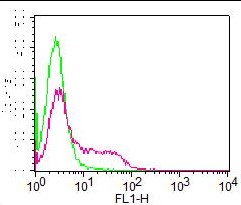Recombinant Human Bcl-2-like Protein 11/BIML (N-6His)(Discontinued)
Shipping Info:
For estimated delivery dates, please contact us at [email protected]
| Amount : | 50 µg |
| Content : | Supplied as a 0.2 µm filtered solution of 20mM HEPES, 150mM NaCl, 10% glycerol, 2mM DTT, pH8.0 |
| Storage condition : | Store at -20°C, stable for 6 months after receipt. Please minimize freeze-thaw cycles. |
| AA sequence : | MNHKVHHHHHHMAKQPSDVSSECDREGRQLQPAERPPQLRPGAPTSLQTEPQDRSPAPMSCDKSTQTPSPPCQAFNHYLSAMASMRQAEPADMRPEIWIAQELRRIGDEFNAYYARRVFLNNYQAAEDHPR |
Source: E.coli.
MW :15kD.
Recombinant Human Bcl-2-like Protein 11 is produced by our E.coli expression system and the target gene encoding Met1-Arg120 is expressed with a 6His tag at the N-terminus. BIML is one of several splice variants of BIM, a proapoptotic protein belonging to the BH-3 domain-only subgroup of Bcl-2 family members. BCL-2 family members form hetero- or homodimers and act as anti- or pro-apoptotic regulators that are involved in a wide variety of cellular activities. BIML is thought to promote apoptosis by binding and inhibiting the activity of anti-apoptotic Bcl-2 family members, thereby inducing the release of cytochrome c from mitochondria. BIML is normally sequestered in an inactive conformation from anti-apoptotic Bcl-2 family members through binding to the microtubule-associated dynein motor complex. Certain apoptotic stimuli release BIML from microtubules to neutralize anti-apoptotic Bcl-2 family members, allowing for the initiation of apoptosis.
MW :15kD.
Recombinant Human Bcl-2-like Protein 11 is produced by our E.coli expression system and the target gene encoding Met1-Arg120 is expressed with a 6His tag at the N-terminus. BIML is one of several splice variants of BIM, a proapoptotic protein belonging to the BH-3 domain-only subgroup of Bcl-2 family members. BCL-2 family members form hetero- or homodimers and act as anti- or pro-apoptotic regulators that are involved in a wide variety of cellular activities. BIML is thought to promote apoptosis by binding and inhibiting the activity of anti-apoptotic Bcl-2 family members, thereby inducing the release of cytochrome c from mitochondria. BIML is normally sequestered in an inactive conformation from anti-apoptotic Bcl-2 family members through binding to the microtubule-associated dynein motor complex. Certain apoptotic stimuli release BIML from microtubules to neutralize anti-apoptotic Bcl-2 family members, allowing for the initiation of apoptosis.
Endotoxin : Less than 0.1 ng/µg (1 IEU/µg) as determined by LAL test.
For Research Use Only. Not for use in diagnostic/therapeutics procedures.
| Subcellular location: | Mitochondrion |
| Post transnational modification: | Ubiquitination by TRIM2 following phosphorylation by MAPK1/MAPK3 leads to proteasomal degradation. Conversely, deubiquitination catalyzed by USP27X stabilizes the protein. |
| Tissue Specificity: | Isoform BimEL, isoform BimL and isoform BimS are the predominant isoforms and are widely expressed with tissue-specific variation. Isoform Bim-gamma is most abundantly expressed in small intestine and colon, and in lower levels in spleen, prostate, testis, heart, liver and kidney. |
| BioGrid: | 115335. 59 interactions. |
|
There are currently no product reviews
|
















.png)













